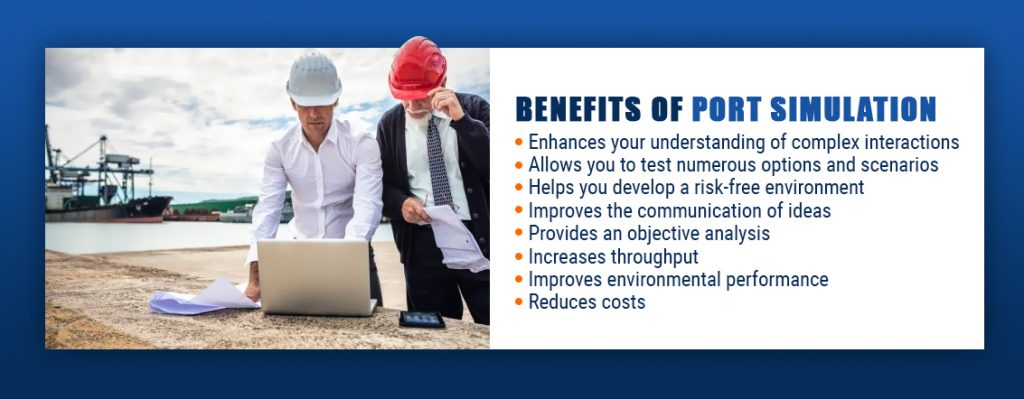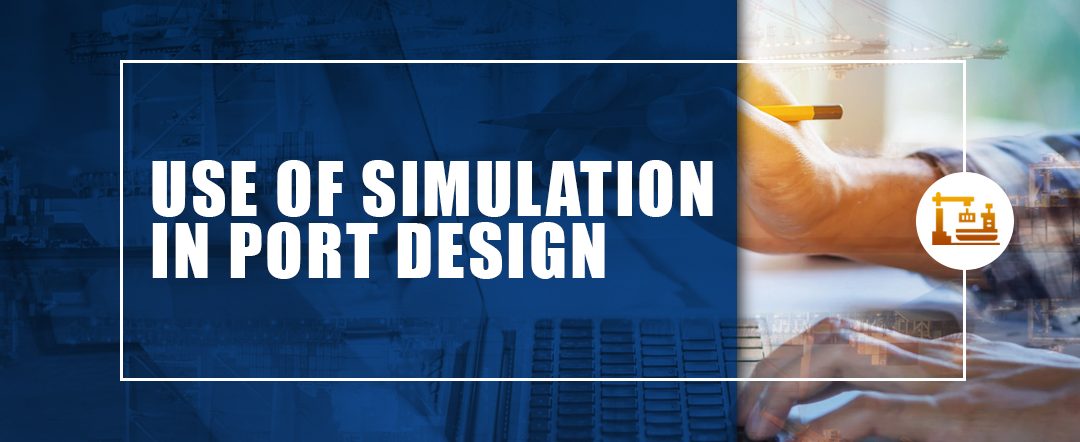Port design is incredibly complex, as there are so many variables at play. Port design can have significant economic, logistical, safety and environmental impacts, so it’s essential that those tasked with port designs take these factors into account and use reliable data to make decisions.
Luckily, simulation can help in considering all relevant data, visualizing options and improving decision making.
How Simulation Is Used in Port Design
Port designers use simulation to test potential designs and determine the optimal layout for a port. These simulators can take a wide array of factors into account, which helps in meeting design goals and avoiding unintended consequences. Simulation software can help port designers answer crucial questions by providing data and visual feedback.
The analysis of complex port systems requires taking an immense number of factors into account, and current port simulation models allow you to do this. Some examples of the many factors they can take into account include:
- Vessel traffic patterns
- Channel geometries
- Docking and undocking procedures
- Vessel type
- Staffing
- Security policies
- Environmental conditions, including wave and well forces, tides, currents, wind and visibility.
Simulation can also help designers account for the effects of inclement weather, natural disasters and other challenges and emergencies. Designers can input information about these factors, or the simulation may be able to pull information from past databases, if available. The system can potentially use data from an operational schedule, a preliminary plan or past vessel activity.
The simulator then determines how these factors will interact in different scenarios and creates visual representations of each. You can analyze the results and how various design options affect factors, such as:
- Safety
- Economics
- Logistics
- Optimal stack heights
- Container throughput
- Resource management
- Environmental performance factors, such as gas, particulates and noise emissions.
You can then compare various scenarios to aid in determining the optimal design based on the expected conditions. Simulation models can also be used for research, modeling of navigational situations, logistics analysis, disruption response, risk mitigation, plan stress testing and other applications.
Benefits of Port Simulation

Why use simulations for port design? Some of the benefits it provides include:
- Enhances your understanding of complex interactions: Ports are busy places, and there is a vast range of variable factors at play. These factors interact with one another, which can lead to unexpected consequences of decisions. For example, changing a design to correct a bottleneck may lead to constraints in another area. Simulation can take these various factors, as well as their dynamic nature, into account, which helps you make improved decisions.
- Allows you to test numerous options and scenarios: Simulation systems allow you to test out numerous design options, whether you’re designing a new system or making small changes. You can also test the effects of various factors, such as increased vessel traffic, changes to port operations constraints and variations in the arrival patterns of ships.
- Helps you develop a risk-free environment: When it comes to port design, it is often too risky or expensive to conduct live tests. With simulation, you can test design ideas in a realistic but risk-free environment.
- Improves the communication of ideas: Simulation modeling provides visual feedback that makes it easier to understand and communicate design ideas. You can see these ideas in action in a realistic virtual environment.
- Provides an objective analysis: Simulations provide objective analyses of designs using verifiable data, enabling port designers to make more informed decisions. Even if data is not available, a simulation can take unknowns into consideration and reveal where the most important missing data is.
- Increases throughput: A simulation program can help you develop designs and strategies to optimize port operation. It can also help in improving the outcomes of negotiations with customers and other stakeholders.
- Improves environmental performance: Simulations can help you see how various factors may affect environmental performance, enabling you to reduce environmental impact and ensure compliance.
- Reduces costs: With simulations, you can see how various design ideas affect costs. For example, improvements in wet infrastructure design and operations can help to reduce costly idle time and demurrage. Simulation can also help to increase throughput, which improves your return on investment.
Case Studies From MITAGS
Below are a few examples of how we have assisted clients in port design using simulations:
- MITAGS was selected as a sub-consultant on a project conducted by Moffatt and Nichol, LLC for the Government of Bermuda. We completed simulations of the Ports of Hamilton and Saint George in Bermuda to evaluate and recommend potential design and operational changes to the shipping channels to accommodate the next generation of cruise ships. For other projects for the Department of Marine and Ports Services of Bermuda, we have modeled various new classes of cruise ships.
- Another project involved programming a simulation of a new iron export terminal for MMX, LLC, Brazil. The terminal, called Project Sudeste Port, is designed to accommodate some of the largest bulk carriers in operation. The project involved detailed modeling of underwater contours and currents.
- We have also programmed and performed simulation studies for M&N to assist in designing a new oil terminal berth in Saint John’s Harbor in Canada. The project included analyses of terminal, channel and assist tug requirements, as well as environmental wind and wave limitations.
Testimonials About MITAGS
Here’s what our clients are saying about us:
- “The Bermuda Government Department of Marine & Ports Services has worked with the MMP MATES Program, undertaking business at MITAGS, on numerous vessel simulation projects, including port development, over the years. We have found their staff to be very professional, and the quality of the simulation facilities to be among the best in the United States.” — Captain Rudolph W. Cann, Director, Gov. of Bermuda, Ministry of Tourism & Transport: Department of Marine & Ports Services
- “As engineers and navigation channel designers, we have found MITAGS to be exceptional in providing near real world ship simulation data to evaluate and make safe, sound and economical management decisions for vessel navigation, channel geometries, docking, undocking, wave/swell forces, wind, tides and currents and other environmental factors and operational procedures.” — Dennis C. Urso, PE, Vice President, Gahagan & Bryant Associates, Inc.
Learn More About Our Simulation Research Capabilities
MITAGS possesses simulation research capabilities that can play a valuable role in port design projects. Our capabilities include maritime research, vessel modeling, visual area modeling, environmental factor modeling and more. We perform simulation research at our campuses in Baltimore, Maryland and Seattle, Washington, and use the latest Wärtsilä (Transas) operating system for our simulators, which offers excellent visual graphics acuity and various unique features.
To learn more, contact us today.





